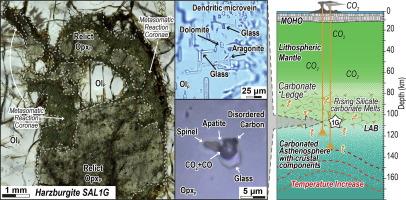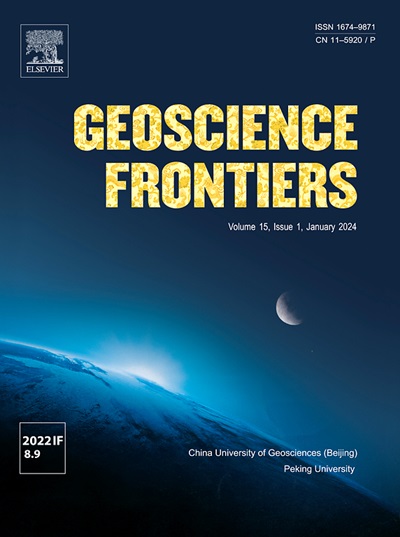佛得角萨尔岛橄榄岩中海洋上地幔的碳富集过程
IF 8.9
1区 地球科学
Q1 GEOSCIENCES, MULTIDISCIPLINARY
引用次数: 0
摘要
本文研究了佛得角萨尔岛橄榄岩中导致碳富集的岩石学和交代过程。地球化学和矿物学分析揭示了一个非均质岩石圈地幔,由超难熔成分表明熔度为20% - 40%的黑根岩和肥沃的尖晶石橄榄岩组成。交代作用的证据是在溶解的正辉石周围形成的反应日冕,由橄榄石、斜辉石、尖晶石和间隙的声纹岩玻璃组成,以及粗溶/声纹岩玻璃+碳酸盐(方解石、文石和白云石)微脉,这些微脉与富CO2流体的熔融包裹体(I型和II型)相关联,穿过橄榄石和正辉石。包裹体中硅酸盐和碳酸盐组分的比例差异很大,可能反映了熔体/流体的非均匀捕获和脱气CO2。热气压测量数据表明,在黑子土中,平衡温度为950至1060°C,在黑子土和橄榄岩中,反应日冕高达1200°C,压力达到文石稳定场(~ 2.2-3.5 GPa,或66-106 km深度)。这些观测结果表明,岩石圈底部渗透着富含碱、铝和挥发物(Cl、S、F、N、P)的硅酸盐-碳酸盐熔体。在微脉中,硅酸盐玻璃成分(例如,K和Ti含量)与来自碳酸化沉积物的实验部分熔体一致,并添加了少量碳酸化榴辉岩。斜辉石中主要元素和微量元素的富集表明,岩石圈底部的富碱硅酸盐-碳酸盐熔体和岩石圈深处的富co2流体、富碱硅酸盐熔体至少发生了两次重要的交代事件,接近碳酸盐岩壁架的压力条件。佛得角群岛下的上地幔中循环碳的引入可能发生在5亿年间影响该地区的多次俯冲事件中,这些事件导致了盘古大陆的形成。与佛得角地幔柱相关的渐新世热扰动引发了地壳成分的主要动员、富含碳酸盐的熔体的产生以及随后的岩石圈交代作用。本文章由计算机程序翻译,如有差异,请以英文原文为准。

Carbon enrichment processes in the oceanic upper mantle preserved in peridotites from Sal Island (Cape Verde)
This study investigates the petrological and metasomatic processes that lead to carbon enrichment in peridotites from Sal Island, Cape Verde. Geochemical and mineralogical analyses reveal a heterogeneous lithospheric mantle, consisting of harzburgites showing ultrarefractory compositions indicative of 20 %–40 % melting degrees, as well as fertile spinel lherzolites. Evidence of metasomatism is demonstrated by the formation of reaction coronae around dissolving orthopyroxene, consisting of olivine, clinopyroxene, spinel, and interstitial phonolitic glass, together with trachytic/phonolitic glass + carbonate (calcite, aragonite, and dolomite) microveins associated with CO2 fluid-rich melt inclusions (Type I and II) cutting through olivine and orthopyroxene. The widely differing proportions of silicate and carbonate components in inclusions likely reflect heterogeneous trapping of melt/fluid and degassing CO2. Thermobarometric data indicate equilibration temperatures from 950 to 1060 °C in harzburgites and up to 1200 °C for reaction coronas in harzburgites and lherzolites, with pressures reaching the aragonite stability field (∼2.2–3.5 GPa, or 66–106 km depth). These observations indicate the infiltration at the base of the lithosphere of a silicate-carbonate melt enriched in alkalies, Al, and volatiles (Cl, S, F, N, P). In microveins, the silicate glass composition (e.g., K and Ti content) is consistent with experimental partial melts derived from carbonated sediments with a minor addition of a carbonated eclogite. Enrichments in major and trace elements in clinopyroxene in harzburgites and lherzolites suggest at least two significant metasomatic events involving alkali-rich silicate-carbonate melts at the base of the lithosphere, and CO2-rich fluid, alkali-rich silicate melts in the deep lithosphere, close to pressure conditions of the carbonate ledge. The introduction of recycled carbon into the upper mantle beneath the Cape Verde archipelago likely occurred during the multiple subduction events that affected the region in the half a billion years leading to the Pangea assembly. Major mobilisation of crustal components, generation of carbonate-rich melts, and subsequent lithospheric metasomatism were triggered by the Oligocene thermal perturbation associated with the Cape Verde mantle plume.
求助全文
通过发布文献求助,成功后即可免费获取论文全文。
去求助
来源期刊

Geoscience frontiers
Earth and Planetary Sciences-General Earth and Planetary Sciences
CiteScore
17.80
自引率
3.40%
发文量
147
审稿时长
35 days
期刊介绍:
Geoscience Frontiers (GSF) is the Journal of China University of Geosciences (Beijing) and Peking University. It publishes peer-reviewed research articles and reviews in interdisciplinary fields of Earth and Planetary Sciences. GSF covers various research areas including petrology and geochemistry, lithospheric architecture and mantle dynamics, global tectonics, economic geology and fuel exploration, geophysics, stratigraphy and paleontology, environmental and engineering geology, astrogeology, and the nexus of resources-energy-emissions-climate under Sustainable Development Goals. The journal aims to bridge innovative, provocative, and challenging concepts and models in these fields, providing insights on correlations and evolution.
 求助内容:
求助内容: 应助结果提醒方式:
应助结果提醒方式:


